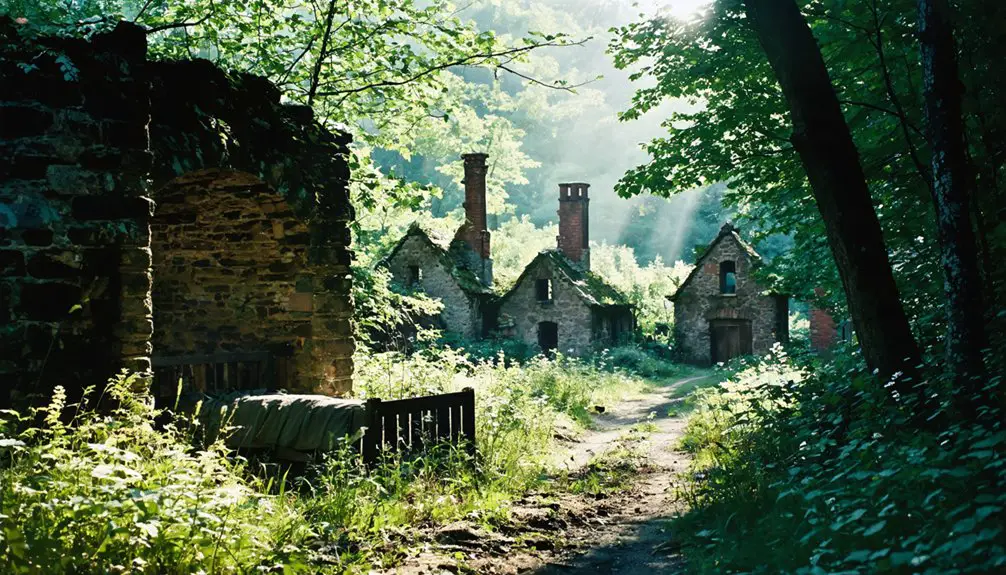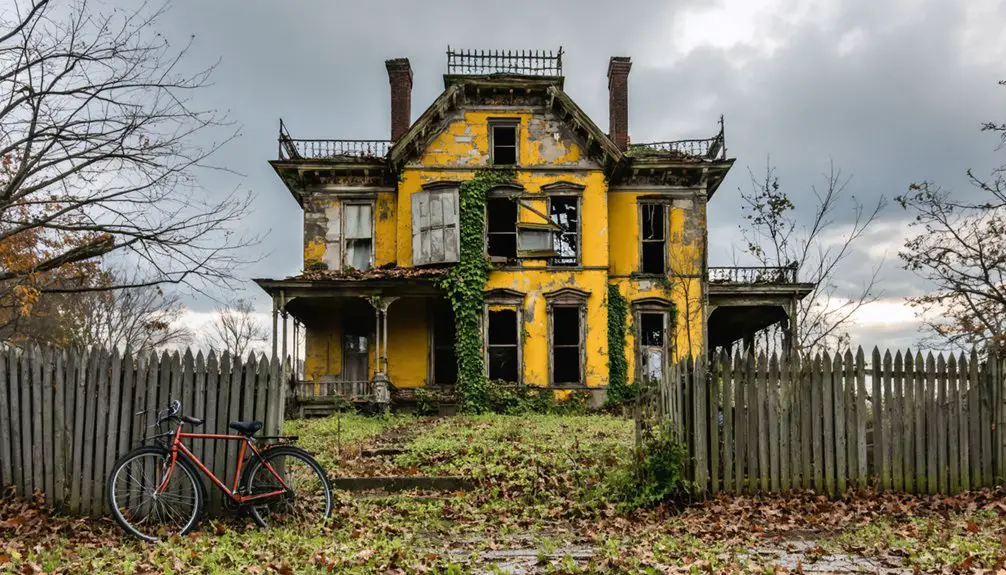You’ll find Doodletown’s ghostly remains hidden within Bear Mountain State Park, where a thriving mountain community of 300-350 residents once lived until 1965. The hamlet’s Dutch name, meaning “dead valley,” hints at its eventual fate when the state park acquired the land, forcing residents to leave their homes. Today, you can explore the old foundations, cemeteries, and stone staircases along the 177E trail, where nature slowly reclaims this forgotten piece of Hudson Valley history.
Key Takeaways
- Doodletown was a thriving mountain community in New York with 300-350 residents until its abandonment in 1965.
- Bear Mountain State Park’s land acquisition forced residents to leave their homes through condemnation by 1962.
- The abandoned town’s remnants include building foundations, stone stairs, and three well-preserved cemeteries accessible via hiking trails.
- Originally settled in 1683, residents sustained themselves through logging, mining, farming, and work at the Iona Island ammunition depot.
- The 689-acre former townsite is now a Wildlife Management Area within Bear Mountain State Park, overtaken by dense forest.
The Dutch Origins Behind the Name
While many abandoned settlements dot the Hudson Valley landscape, Doodletown‘s name carries a distinct Dutch heritage that dates back to colonial times.
You’ll find its origins in the Dutch word “Dooddel,” meaning “dead valley,” reflecting the Dutch naming tradition of describing geographic features throughout the region.
When English settlers arrived, they simply added “-town” to the original Dutch term, creating the name that’s endured for centuries.
This cultural influence didn’t stop at Doodletown – you can see Dutch colonial spatial patterns and naming conventions throughout the Hudson Valley.
The name exemplifies how Dutch settlers left their mark on the region’s identity, joining other Dutch-influenced landmarks like Anthony’s Nose.
From Anthony’s Nose to Doodletown, Dutch settlers shaped the Hudson Valley’s landscape through the names they bestowed upon its landmarks.
It’s a reflection of the lasting impact of Dutch colonial presence in New York’s early development.
The area experienced its greatest population growth in the 1940s when 300 to 350 residents called this valley home.
Thomas Edison attempted to mine and refine iron ore in the area during the 1890s, though the venture ultimately failed.
Life in a Mountain Community
Tucked between five towering mountains of the Hudson Highlands, Doodletown‘s tight-knit community of 300-350 residents thrived as a self-sufficient mountain hamlet during its peak in the 1940s.
The mountain resilience of these hardy folk shaped their community dynamics, with families tracing their roots back to French Huguenot settlers. The town’s Dutch name meaning Dead Valley reflected its remote location nestled in the mountains. The area’s original inhabitants, the Munsee Indians, lived in the valley long before European settlement began.
Life centered around four essential pillars:
- Making a living through logging, mining, farming, and working at the Iona Island ammunition depot
- Gathering at the Mountville Presbyterian Church for worship, education, and social events
- Surviving harsh winters through mutual support and shared resources
- Maintaining strong multi-generational bonds that kept traditions alive
You’d find a remarkable spirit of independence here, where residents built their homes from local materials and sustained themselves through centuries of mountain living.
The Battle for Land and Preservation
Following World War II, Bear Mountain State Park‘s systematic acquisition of private homes marked the beginning of Doodletown’s transformation from vibrant mountain community to preserved wilderness.
By 1962, the park’s land consolidation efforts led to the official condemnation of remaining homes, with the last residents departing by 1965.
The ski slope project that drove residents out never materialized, leaving the land to return to wilderness.
Today, you’ll find nonprofits like Friends of Doodletown working to protect the site’s historical significance while balancing natural preservation.
They’ve installed interpretive signs identifying former property locations and maintain the area’s cemeteries, schoolhouses, and churches.
The 689-acre site now serves as a designated Wildlife Management Area, supporting diverse species from New England cottontails to rare warblers.
However, recent natural disasters, including severe storms in 2023, continue to challenge preservation efforts, requiring careful restoration to protect both historical remnants and wildlife habitats.
From Vibrant Town to Abandoned Ruins
The story of Doodletown’s transformation from settlement to ghost town begins in 1683, when Stephanus van Courtlandt acquired the territory from its original Munsee-Lenape inhabitants.
The community’s historical significance grew as French Huguenot descendants and pioneering families like the Junes shaped a resilient settlement that would last nearly 200 years. The residents adapted their livelihoods from mining and logging to tourism-related work by the 1920s.
French Huguenots and pioneer families built a resilient community that would endure through two centuries of challenges and change.
Today, Doodletown remains a popular destination for visitors exploring the Hudson Valley region.
You’ll find Doodletown’s decline marked by these pivotal changes:
- Government land acquisition efforts starting in the early 20th century
- Forced displacement of residents through eminent domain by 1965
- Demolition of most structures, including the vandalized schoolhouse in 1980
- Nature’s gradual reclamation, leaving only foundations, roads, and cemeteries
The community’s resilience, evident in their centuries-long persistence against harsh winters and challenges, ultimately couldn’t withstand government intervention for park expansion.
Exploring the Hidden Valley Today
You’ll find Doodletown’s remnants by following the historic 177E trail through Bear Mountain State Park, where paths once used during the Revolutionary War now guide modern explorers.
Nature has steadily reclaimed what was once a bustling community, with dense forest growth now covering old foundations, cellar holes, and stone stairs that hint at past lives. The tranquil setting echoes the quiet, idyllic lifestyle that residents enjoyed before the town’s abandonment.
While the stone schoolhouse is gone and most structures were demolished after 1965, you can still discover three well-preserved cemeteries that maintain living connections to former residents.
Trail Access Points
Modern-day visitors can access Doodletown’s hidden valley through three main trailheads, with the Cornell Mine Trail serving as the primary entrance point off Route 9W near Tomkins Cove, NY.
Parking options are limited to roadside spots along Route 9W, with some space available near the Iona Bird Sanctuary and just north of Iona Island Road.
The area offers hikers access to over 235 marked trails throughout the combined parkland.
The trails lead visitors past historic foundations and two cemeteries that tell the story of the former village.
When planning your visit, keep in mind:
- Access is free but restricted to daylight hours only
- No dedicated parking lots exist specifically for Doodletown
- The Cornell Mine Trailhead offers the most direct route to historic sites
- You’ll find additional roadside parking near the trail intersections with 9W
Remember to arrive early during peak hiking seasons, as available parking fills quickly along these access points.
Nature Reclaims Past Life
Wandering through Doodletown’s hidden valley today, visitors encounter a landscape where nature has steadily erased most traces of human habitation since 1965.
You’ll find thick forest and underbrush dominating where 70 homes once stood, showcasing nature’s resilience in reclaiming abandoned spaces.
As you explore, you’ll discover subtle hints of the past – crumbling foundations, old staircases, and road stencils barely visible through the vegetation.
The urban decay is most evident in the remnants of the school building, once a hiker’s shelter before vandals destroyed it.
Yet the cemeteries remain largely untouched, regularly visited by descendants who maintain their ancestral connections.
This post-human landscape serves as a humbling reminder of time’s passage, where daily human concerns have been quietly buried beneath decades of natural growth.
Echoes of a Lost Community
As you walk the overgrown paths of Doodletown today, you’ll encounter stone foundations and staircases that whisper stories of the families who once called this valley home.
The preserved graveyards, still decorated by descendants, offer tangible connections to over 200 years of community life that flourished here until 1965.
Nature’s steady advance through the abandoned townsite transforms these architectural remnants into powerful memorials, where the ghosts of daily life linger in the quiet spaces between forest and stone.
Memory Through Stone Remnants
Deep within Bear Mountain State Park‘s forested terrain, stone remnants of Doodletown tell stories of a once-thriving community that flourished from 1762 until its final abandonment in 1965.
These stone narratives reveal the cultural significance of a settlement that adapted to valley life, marked by foundations of roughly 70 homes and public buildings.
You’ll find these enduring markers of Doodletown’s past:
- Moss-covered stone foundations tracing the layout of homes and community structures
- Cemetery headstones preserving family histories and cultural memories
- Stone staircases and concrete footpaths marking former streets and pathways
- Church and school ruins symbolizing the hamlet’s social heart
Nature now reclaims these stone remnants, yet they persist as silent storytellers of abandoned lives and resilient spirits.
Lives Forever Marked Here
Beyond stone ruins and crumbling foundations, Doodletown’s enduring legacy lives through the stories of its people – from French Huguenot descendants to native Munsee Lenape inhabitants who first called this valley home.
You’ll find the deepest community memory preserved in the Herbert-Weyant Cemetery and other burial grounds, where generations of families rest undisturbed.
These sacred spaces forge ancestral connections that even eminent domain couldn’t erase. While the Palisades Interstate Park Commission forced residents out in the 1960s, breaking centuries of continuous habitation, the graveyards stand as silent witnesses to those who built lives here.
Through commemorative gatherings and respectful visits, descendants maintain ties to their roots. Each headstone tells a story of the tight-knit rural community that flourished in this valley before its untimely end.
Nature Reclaims Human History
Through the silent valley where Doodletown once thrived, nature’s persistent advance has transformed a bustling community into a haunting tableau of stone foundations and overgrown pathways.
You’ll witness nature’s resilience as forests reclaim what was once a vibrant hamlet, with vegetation steadily erasing human footprints from the landscape.
In this reflection of human impermanence, you’ll discover:
- Crumbling foundations wrapped in persistent vines and wild brush
- Former roadways now reduced to ghostly outlines beneath encroaching plants
- Empty clearings where homes and the schoolhouse once hosted daily life
- Silent cemeteries standing as the last markers of civilization
The land’s return to wilderness serves as a powerful reminder that even our most permanent structures are temporary against time’s unstoppable march.
Frequently Asked Questions
Were There Any Documented Paranormal Activities in Doodletown After Its Abandonment?
As quiet as a forgotten prayer, you won’t find documented ghost sightings in this abandoned town. Despite its eerie setting, no credible paranormal investigations have uncovered supernatural activity after residents departed.
What Happened to the Personal Belongings Left Behind by Evicted Residents?
You’d find most abandoned belongings were destroyed during building demolitions after the eviction aftermath, with no systematic preservation efforts. Items left behind likely vanished through demolition, vandalism, and natural deterioration.
Did Any Former Residents Attempt Legal Action Against the Forced Evictions?
You won’t find records of legal battles against the 1965 evictions, as residents lacked modern eviction rights and tenant protections. The state’s eminent domain power gave them little opportunity for legal recourse.
What Natural Resources or Industries Sustained Doodletown Before Its Decline?
Like early American pioneers, you’d have found thriving timber industry operations and mining activities sustaining the community, alongside small-scale farming and later employment opportunities at Iona Island’s naval depot.
How Many Original Structures From Doodletown Still Stand Today?
You won’t find any original standing buildings in today’s Doodletown. Despite historical preservation efforts, only foundations, staircases, and cellar holes remain, with the last structure demolished in 1980.
References
- https://rooseveltislanddaily.news/2019/04/24/doodletown-suburban-ghost-town/
- https://943litefm.com/abandoned-ghost-towns-new-york/
- https://theghostinmymachine.com/2025/01/13/abandoned-the-last-remnants-of-doodletown-new-york/
- https://midatlanticdaytrips.com/2022/06/doodletown/
- https://hudsonvalleycountry.com/doodletown-a-look-inside-the-hudson-valleys-most-popular-ghost-town/
- https://www.thetravel.com/doodletown-abandoned-ny-haunted/
- https://www.iamexpat.nl/expat-info/dutch-news/dutch-heritage-new-york
- https://en.wikipedia.org/wiki/Doodletown
- https://extapps.dec.ny.gov/docs/wildlife_pdf/yfidoodlehmp.pdf
- https://www.rocklandaudubon.org/new-page



